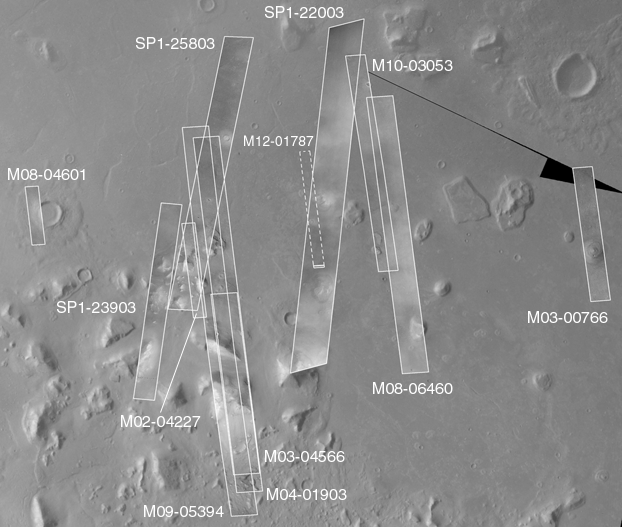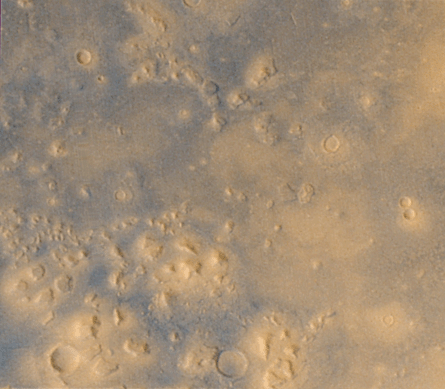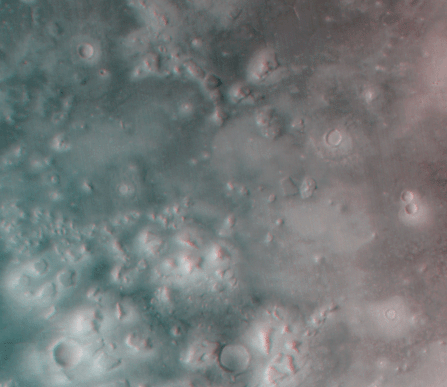
Mars Global Surveyor
Mars Orbiter Camera
Cydonia: Two Years Later
MGS MOC Release No. MOC2-222, 5 April 2000

FIGURE 1: Viking Orbiter mosaic showing landforms in Cydonia with popular, informal names.
The recent motion picture, "Mission to Mars,"
takes as part of its premise that certain features in the Cydonia region
of Mars were constructed as monuments by ancient Martians. This idea---widely
popularized in books, magazines, tabloids and other
news/infotainment media---has its origin in the chance observation (in 1976)
by one of the Viking Orbiter spacecraft of a
face-like
hill. The "face" and other nearby landforms are labeled in the above
mosaic of Viking Orbiter images from the 1970s.
On April 5, 1998, the Mars Global Surveyor (MGS) spacecraft
performed a specially-planned maneuver to photograph the
"Face on Mars." Having successfully
imaged the "Face" on its first attempt, two
additional maneuvers were used to observe other purported
"artifical" features:
the "City"
(a cluster of small mountains west-southwest of the "Face") and
the "City Square"
(a group of four small hills surrounded by the larger mountains of the
"City"). These special observations occurred during the
Science Phasing Orbits period of the MGS mission, while
the spacecraft was in a 12 hour, elliptical orbit. A year later, in March
1999, MGS attained its final, circular, polar Mapping Orbit, from which
it has now subsequently observed the planet for a year. During this year
of mapping, the Mars Orbiter Camera (MOC) has continued to make observations
within the Cydonia region whenever the MGS spacecraft has flown over that
area.
Narrow Angle Camera Views of Cydonia

FIGURE 2: Location of MOC images acquired during the past two years, April 1998 to April 2000. Click on ID numbers to browse
the images. These are presented at 40% size with north approximately "up". For full-resolution images, see list below.
The above figure shows the location of all high resolution (narrow angle)
MOC images of the Cydonia region that have been obtained to date,
including the first three taken in 1998. Images acquired during
the Science Phasing Orbit period of 1998 slant from bottom left
to top right; Mapping Phase images (from 1999 and 2000) slant from
lower right to upper left. Owing to the nature of the orbit, and in
particular to the limitations on controlling the location of the orbit,
the longitudinal distribution of images (left/right in the images above)
is distinctly non-uniform.
An attempt to take a picture of a portion of
the "Face" itself (M12-01787) in mid-February 2000
was foiled when the MGS spacecraft experienced a
sequencing error and most
of that day's data were not returned to Earth. Only the first 97 lines
of M12-01787 were received; the image's planned footprint is shown as
a dashed box.
Wide Angle Camera Views of Cydonia

FIGURE 3: Wide Angle Color Image from May 1999.
100 m/pixel 1 MByte Version

FIGURE 4: Wide Angle Stereo Anaglyph from May 1999.
100 m/pixel 1 MByte Version
Although the resolution of the MOC wide angle cameras is too low to
tell much about the geomorphology of the Cydonia region, the images
from the red and blue wide angle cameras provide us with two types
of information that is of interest in their own right: color and
stereoscopic data. Above are a color view and a stereoscopic anaglyph
rendition of Geodesy Campaign images acquired by MGS MOC in May 1999.
To view the stereo image, you need red/blue "3-d" glasses.
Additional Information and Views
40% Views Accessed Via Figure 2:
Each of the high resolution, or narrow angle, views of the Cydonia
region that can be accessed by clicking on the ID numbers in Figure 2
has been processed to remove the vertical striping that is caused by
the non-uniform sensitivity of the MOC narrow angle camera; rotated so
that north is approximately "up" and east is toward the right;
linearly-stretched to show details/contrast, and
reduced to 40% of its original size so that it can be viewed with most
web-browsing software. Non-unity aspect ratios have not been corrected
in these views.
Full-Resolution Views Accessed by ID Numbers Below:
The full-resolution views of each Cydonia image are provided
in the list below. Each has been processed to remove the
vertical striping that is caused by the non-uniform sensitivity
of the MOC narrow angle camera. No additional processing has been
applied. In particular, these images are usually not oriented with north to
the top. Many also have aspect ratios greater than 1 (this means
that craters will look "squished"). For those who want detailed information
on these images that can be used to process them further, an
ancillary data table
is provided. Some of the full-resolution images are too large to
be viewed in your web-browser; the "save this link as" option
should be used to download the image to your desktop, then open
it with your favorite image viewing or image processing software.
All pictures are in GIF format.
Several Large views of Figure 2 without labels:
All Images Please Credit: NASA/JPL/Malin Space Science Systems
Malin Space Science Systems and the California Institute of
Technology built the MOC using spare hardware from the Mars Observer
mission. MSSS operates the camera from its facilities in San Diego,
CA. The Jet Propulsion Laboratory's Mars Surveyor Operations Project
operates the Mars Global Surveyor spacecraft with its industrial
partner, Lockheed Martin Astronautics, from facilities in Pasadena, CA
and Denver, CO.
 To MSSS Home Page
To MSSS Home Page





